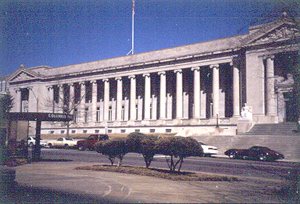
Shelby County
The Tennessee General Assembly established Shelby County on November 24, 1819, just a little over a year after the “Jackson Purchase” and Chickasaw treaty freed West Tennessee from Indian claims. The county is named after one of the successful treaty commissioners, Isaac Shelby, a Revolutionary War veteran and former governor of Kentucky. Although sparsely populated at the time, Shelby County began its existence as Tennessee’s largest (784 square miles) in area and is now also the largest county in population (over 860,000 people).
From the beginning, Shelby County enjoyed a geographical advantage as a travel and trade center. The Chickasaws had already established trails from the fourth Chickasaw Bluff (future Memphis) to future northwest Alabama and northeast Mississippi (now U.S. Highways 72 and 78 respectively) in order to gain access to early Mississippi River trade. Originally these trails followed ridge lines between river basins in order to facilitate all-weather travel. Later they would become the basic routes for early railroads, which would make Shelby County and its principal city, Memphis, the economic center of the region.
The first meeting of the Shelby County Quarterly Court was held on May 1, 1820, and authorized $125 for the construction of a log courthouse and jail along with a property tax of $6.25 per 100 acres of land. It also authorized the conduct of a county survey which officially reported three years later that the county contained only 625 acres, because of a state boundary error by James Winchester which had sliced a strip four miles wide and approximately thirty miles long off the bottom of Shelby County and recorded it as being in Mississippi. The error was not discovered until 1835, but is commemorated today by Winchester Road, which follows his state boundary survey line. Shelby County property in this strip is still neatly delineated by the Mississippi survey system of section and quarter sections while the northern 80% of the county uses the older Tennessee survey system of “metes and bounds.”
In 1826 Memphis was incorporated as a town, but almost two years earlier, the county seat had been relocated to the village of Raleigh at Sanderlin’s Bluff on the Wolf River, squarely in the center of the county. There it remained until after the Civil War, when in 1868 the clamor of lawyers and litigants brought it back to Memphis. Other early settlements include Big Creek (south of present Millington), which apparently was home to several families even before the Chickasaw treaty, and the log cabin which would expand into Davies Manor at Brunswick dates from 1807. Obviously, these early settlers had made their own arrangements with the Indians. Near Big Creek, further south towards Memphis, was the Egypt settlement, part of the exotic Egyptian-naming era which swept southern Illinois and West Tennessee from around 1818 to 1820.
Other areas of Shelby County were also receiving attention. In 1825 an idealistic young Scotswoman named Frances Wright acquired 2,000 acres of wilderness property about four miles upstream of Raleigh on the Wolf River. There in early 1826 she and her younger sister, Camilla, began a noble experiment. They established a plantation named Nashoba upon which black slaves could work and earn sufficient credit to purchase their freedom. The surplus funds would be used to buy more slaves and repeat the cycle. However, there were no profits, and in 1829 Wright ended the project but kept the property, eventually leaving it to a niece who only parted with the last remaining acreage in 1900. Today it comprises the southeast quadrant of the Shelby County Penal farm (Shelby Farms) and the western subdivision of Germantown located north of the Norfolk-Southern Railroad (earlier the Memphis and Charleston Railroad). Germantown now has a population of nearly 32,000.
During the nineteenth century, lasting towns were also established at Bartlett (currently Shelby County’s second most populated, with more than 40,543 people); Collierville (31,877) grew 120 percent between 1990 and 2000; Millington (10,443); and Arlington (2,568), which had a rate of 66.7 percent growth over the last ten years. Several twentieth-century incorporations have been attempted, but only one, Lakeland, has survived. Census officials place Memphis’s population at 650,100 in 2000.
The county government continued to be based upon the accepted statewide quarterly court pattern until the Civil War. During the years 1862-64 it neither met nor functioned. During Reconstruction it ran afoul of Governor William G. Brownlow, who used the coercive Metropolitan Police Act to abolish it and replace it with a five-member commission appointed by himself. When the state constitution was rewritten in 1870, a section of it was aimed directly at preventing a repeat of this practice by providing that county officials must either be elected by the people or the Quarterly Court.
However, by 1910 the Shelby County Quarterly Court with its unwieldy fifty members had grown too large and too democratic. Legendary political boss E. H. Crump superimposed control through a 1911 legislative act creating a three-member executive commission which could override the court on all items except the constitutionally protected power to set property taxes. Only after Crump’s death in 1954 did this arrangement become unworkable.
Not until 1975 were governance problems solved when the people voted to ratify the Shelby County Restructure Act, creating a single executive with the title of mayor and a single eleven-member legislative body (now called the County Commission). The third mayor, Jim Rout, now holds office and the system works well.



